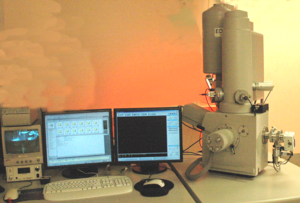Difference between revisions of "Scanning Electron Microscope"
| Line 1: | Line 1: | ||
=== Overview === | === Overview === | ||
[[Image:Sirion_sem.png|thumb|300px|]] | [[Image:Sirion_sem.png|thumb|300px|]] | ||
The scanning electron microscope is used to image the surface of a conducting sample by scanning it with a high energy beam of electrons. Some SEMs have additional software enhancements than enable them to focus the beam on a photomask for [[E-beam lithography]] or are equipped for focused ion beam (FIB) milling. | The scanning electron microscope is used to image the surface of a conducting sample by scanning it with a high energy beam of electrons. Some SEMs have additional software enhancements than enable them to focus the beam on a photomask for [[E-beam lithography]] or are equipped for focused ion beam (FIB) milling. The SEM is a useful tool for photonics research because it reveals nano-scale surface features and topography that is critical to the performance of multi-layer devices. | ||
Revision as of 09:21, 21 December 2009
Overview
The scanning electron microscope is used to image the surface of a conducting sample by scanning it with a high energy beam of electrons. Some SEMs have additional software enhancements than enable them to focus the beam on a photomask for E-beam lithography or are equipped for focused ion beam (FIB) milling. The SEM is a useful tool for photonics research because it reveals nano-scale surface features and topography that is critical to the performance of multi-layer devices.
See Wikipedia on Scanning Electron Microscope
Operation
Part 1 Tour and Sample Preparation
Part 2 Loading the Sample
Part 3 Setting the Working Distance
Part 4 Lens Alignment and Stigmation
Part 5 Moving the Stage and Imaging
Part 6 Changing the Sample and Shutdown
Training Manual for Sirion SEM[1]
Training Video on Hitachi 3500H SEM at GT MiRC
